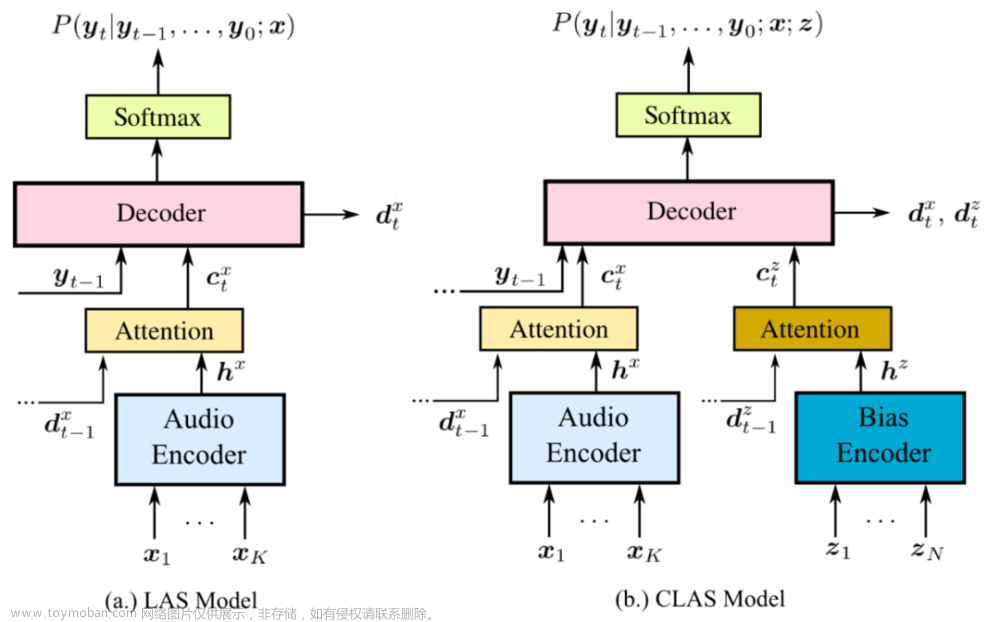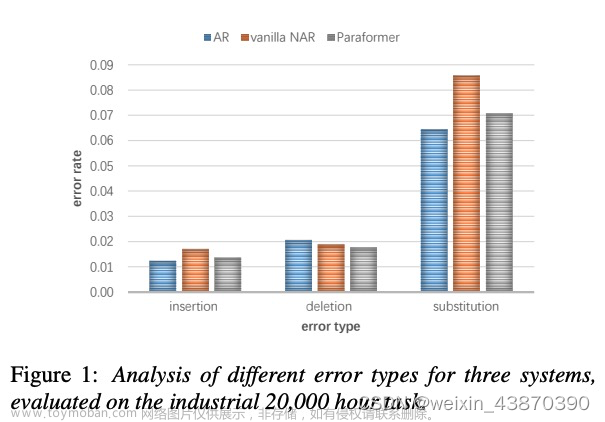WeNet:面向工业落地的E2E语音识别工具
一、WeNet语音识别平台搭建
1、参考资料
- wenet-e2e/wenet
- Mozilla DeepSpeech
- yeyupiaoling/PaddlePaddle-DeepSpeech
2、快速搭建WeNet平台
参考 WeNet中文文档
下载官方提供的预训练模型,并启动 docker 服务,加载模型,提供 websocket 协议的语音识别服务。
wget https://wenet-1256283475.cos.ap-shanghai.myqcloud.com/models/aishell2/20210618_u2pp_conformer_libtorch.tar.gz
tar -xf 20210618_u2pp_conformer_libtorch.tar.gz
model_dir=$PWD/20210618_u2pp_conformer_libtorch
docker run --rm -it -p 10086:10086 -v $model_dir:/home/wenet/model wenetorg/wenet-mini:latest bash /home/run.sh
Note:
-
这里的
$PWD = "/home/wenet/model"。 -
一定要保证预训练模型文件的存储位置要正确,即解压在
$PWD下,执行如下命令model_dir=$PWD/20210618_u2pp_conformer_libtorch进行变量赋值,否则会报:
实时识别
使用浏览器打开文件**index.html,在 WebSocket URL 中填入 ws://127.0.0.1:10086 (若在windows下通过wsl2**运行docker, 则使用ws://localhost:10086) , 允许浏览器弹出的请求使用麦克风,即可通过麦克风进行实时语音识别。
这里使用wsl2下的docker进行演示:如果靠近麦克风,误检率比较低。

二、WeNet实现推理(暂时无法使用onnx cpu版本进行推理)
Note:
-
如果仅使用wenet/bin/recognize.py,使用libTorch模型进行推理,可以在windows中搭建环境,具体搭建过程参考WeNet官网
-
如果要使用wenet/bin/recognize_onnx.py进行推理,需要先下载ctc_encoder,这里要注意pypi上的ctc_encoder只有2020的版本(WeNet1.0),和当前的WeNet3.0版本不一致,因此需要到https://github.com/Slyne/ctc_decoder下载并编译。由于编译swig_encoder过程中需要用到bash命令,所以尝试在linux系统中运行,这里使用WSL + ubuntu作为解决方案。
其实windows安装git就可以执行bash命令,只不过这里在安装好
wget.exe,swig.exe,git clone相应的package(kenlm,ThreadPool)之后,对于下载的openfst-1.6.3,即使在VC中补全了.h文件,无法编译成功。
1、搭建WeNet环境
这里由于要尝试使用onnx推理模型,因此使用WSL + ubuntu作为解决方案
WSL + Docker Desktop 的使用教程参考 WSL Ubuntu + Docker Desktop搭建python环境
在完成好WSL和Docker Desktop安装之后,WeNet环境配置步骤如下:
-
实例化anaconda容器
docker run -it --name="anaconda" -p 8888:8888 continuumio/anaconda3 /bin/bash如果退出了,可以重启anaconda容器
#重启 docker start anaconda docker exec -it anaconda /bin/bash -
在base环境下配置wenet环境(不要创建虚拟环境,方便之后打包成镜像,供pycharm使用)
将WSL中的wenet项目拷贝到docker容器中(假设在WSL的
/home/usr下有wenet项目)docker cp /home/usr/wenet/requirements.txt 9cf7b3c196f3:/home/ #9cf7b3c196f3为anaconda容器id进入anaconda容器内,在
/home/使用pip安装所有包(conda源修改参考 ubuntu更换conda源 )pip install -r requirements.txt -i https://pypi.tuna.tsinghua.edu.cn/simple conda install pytorch=1.10.0 torchvision torchaudio=0.10.0 cudatoolkit=11.1 -c pytorch -c conda-forge -
下载ctc_encoder项目(让conformer进行语音识别时能够使用beam_search方法)
ctc_encoder官网如下:https://github.com/Slyne/ctc_decoder.
由于
github clone在ubuntu中可能不好使,所以在windows中进入swig/setup.sh:#!/usr/bin/env bash if [ ! -d kenlm ]; then git clone https://github.com/kpu/kenlm.git echo -e "\n" fi if [ ! -d openfst-1.6.3 ]; then echo "Download and extract openfst ..." wget http://www.openfst.org/twiki/pub/FST/FstDownload/openfst-1.6.3.tar.gz --no-check-certificate tar -xzvf openfst-1.6.3.tar.gz echo -e "\n" fi if [ ! -d ThreadPool ]; then git clone https://github.com/progschj/ThreadPool.git echo -e "\n" fi echo "Install decoders ..." # python3 setup.py install --num_processes 10 python3 setup.py install --user --num_processes 10将必要的包安装好后(在
git bash中使用setup.sh中的命令,wget,swig直接安装exe即可),整体文件结构如下(多了这四个文件):
再把完整的ctc_encoder复制到anaconda容器中,直接进行编译即可。
-
编译ctc_encoder:
假设现在在anaconda容器中,ctc_encoder项目在
/home目录下,进入swig文件夹后,运行bash setup.sh即可完成编译(需要先apt install gcc,apt install g++) -
配置onnx,onnxruntime环境
pip install onnx==1.9.0 -i https://pypi.tuna.tsinghua.edu.cn/simple pip install onnxruntime==1.9.0 -i https://pypi.tuna.tsinghua.edu.cn/simple -
将Docker运行时容器打包成镜像
将anaconda容器运行时的环境打包成镜像,给pycharm专业版调用,参考Pycharm使用docker容器内的环境开发
#OPTIONS说明: # -a :提交的镜像作者; # -c :使用Dockerfile指令来创建镜像; # -m :提交时的说明文字; # -p :在commit时,将容器暂停。 #2b1ad7022d19为anaconda容器运行时的id docker commit -a "wangxiaoxi" -m "wenet_env" 2b1ad7022d19 wenet_env:v1
2、模型训练
参考Tutorial on AIShell
3、基于libTorch模型的推理
下载aishell2 sample数据集进行wenet模型的推理,官网如下:希尔贝壳
下载WeNet的预训练模型(下载Checkpoint model - conformer)
将测试数据集和预训练模型放在项目路径下,比如:

修改train.yaml中的cmvn_file的位置(如果使用docker容器中的python环境,建议使用相对路径)
cmvn_file: ../../test/aishell2/global_cmvn #这里使用相对路径
将aishell2数据集修改成wenet数据格式
{"key": "D4_753", "wav": "../../test/aishell2/test_data/D4_750.wav", "txt": ""}
{"key": "D4_754", "wav": "../../test/aishell2/test_data/D4_751.wav", "txt": ""}
{"key": "D4_755", "wav": "../../test/aishell2/test_data/D4_752.wav", "txt": ""}
{"key": "D4_753", "wav": "../../test/aishell2/test_data/D4_753.wav", "txt": ""}
{"key": "D4_754", "wav": "../../test/aishell2/test_data/D4_754.wav", "txt": ""}
{"key": "D4_755", "wav": "../../test/aishell2/test_data/D4_755.wav", "txt": ""}
{"key": "D4_756", "wav": "../../test/aishell2/test_data/D4_756.wav", "txt": ""}
使用wenet/bin/recognize.py,输入如下命令
python recognize
--config=../../test/aishell2/train.yaml \
--dict=../../test/aishell2/units.txt \
--checkpoint=../../test/aishell2/final.pt \
--result_file=../../test/aishell2/att_res_result.txt \
--test_data=../../test/aishell2/test_data/data.list \
输出结果如下:
Namespace(batch_size=16, beam_size=10, bpe_model=None, checkpoint='../../test/aishell2/final.pt', config='../../test/aishell2/train.yaml', connect_symbol='', ctc_weight=0.0, data_type='raw', decoding_chunk_size=-1, dict='../../test/aishell2/units.txt', gpu=-1, mode='attention', non_lang_syms=None, num_decoding_left_chunks=-1, override_config=[], penalty=0.0, result_file='../../test/aishell2/att_res_result.txt', reverse_weight=0.0, simulate_streaming=False, test_data='../../test/aishell2/test_data/data1.list')
2022-07-04 15:54:22,441 INFO Checkpoint: loading from checkpoint ../../test/aishell2/final.pt for CPU
F:\ASR\wenet\wenet\transformer\asr_model.py:266: UserWarning: __floordiv__ is deprecated, and its behavior will change in a future version of pytorch. It currently rounds toward 0 (like the 'trunc' function NOT 'floor'). This results in incorrect rounding for negative values. To keep the current behavior, use torch.div(a, b, rounding_mode='trunc'), or for actual floor division, use torch.div(a, b, rounding_mode='floor').
best_hyps_index = best_k_index // beam_size
2022-07-04 15:54:27,189 INFO D4_753 中国人民保险集团股份有限公司闽宁营销服务部
2022-07-04 15:54:27,189 INFO D4_755 中国电信闽宁镇合作营业厅
2022-07-04 15:54:27,189 INFO D4_754 闽宁镇卫生院
2022-07-04 15:54:27,189 INFO D4_756 闽宁镇客运站
2022-07-04 15:54:27,189 INFO D4_753 第六十一集
2022-07-04 15:54:27,189 INFO D4_755 第六十三集
2022-07-04 15:54:27,189 INFO D4_754 第六十二集
4、WeNet导出onnx模型
参考 ONNX backend on WeNet
这里先下载WeNet的预训练模型(下载Checkpoint model - conformer),接着使用wenet/bin/export_onnx_cpu.py, 设置如下参数,即可将libtorch的pt文件转换成onnx文件
python export_onnx_cpu.py
--config F:/ASR/model/20210618_u2pp_conformer_libtorch_aishell2/train.yaml \
--checkpoint F:/ASR/model/20210618_u2pp_conformer_libtorch_aishell2/final.pt \
--chunk_size 16 \
--output_dir F:/ASR/model/20210618_u2pp_conformer_libtorch_aishell2/onnx_dir \
--num_decoding_left_chunks -1
如果onnx导出成功,会在输出文件夹中生成如下3个文件:encoder.onnx,ctc.onnx, decoder.onnx。
5、使用recognize_onnx进行推理(未解决)
参考 https://github.com/wenet-e2e/wenet/pull/761.
先下载conformer模型的权重文件(checkpoint model),https://wenet.org.cn/wenet/pretrained_models.html
解压好权重文件之后,文件夹目录如下

修改train.yaml中的cmvn_file的位置
#cmvn_file: F:/ASR/model/20210618_u2pp_conformer_libtorch_aishell2/global_cmvn
cmvn_file: ../../test/aishell2/global_cmvn #这里使用相对路径
转换成wenet的json数据格式:假设现在有音频文件D4_750.wav,通过格式转换成如下json格式, 参考https://wenet.org.cn/wenet/tutorial_librispeech.html?highlight=test_data#stage-0-prepare-training-data
{"key": "D4_753", "wav": "../../test/aishell2/test_data/D4_750.wav", "txt": "而对楼市成交抑制作用最大的限购"}
接着运行:
python3 wenet/bin/recognize_onnx.py --config=20210618_u2pp_conformer_exp/train.yaml --test_data=raw_wav/test/data.list --gpu=0 --dict=20210618_u2pp_conformer_exp/words.txt --mode=attention_rescoring --reverse_weight=0.4 --ctc_weight=0.1 --result_file=./att_res_result.txt --encoder_onnx=onnx_model/encoder.onnx --decoder_onnx=onnx_model/decoder.onnx
注意这里最好使用相对路径,因为使用的是docker里的python环境,如果在读取文件时使用windows下的绝对路径,会导致如下错误。解决思路参考https://github.com/microsoft/onnxruntime/issues/8735(反正我解决不了)
{FileNotFoundError}[Errno 2] No such file or directory: 'F:/ASR/model/20210618_u2pp_conformer_libtorch_aishell2/train.yaml'
这里使用export_onnx_cpu导出的onnx模型,使用recognize_onnx进行推理
encoder_ort_session=onnxruntime.InferenceSession(encoder_outpath, providers=['CPUExecutionProvider']);
ort_inputs = {
encoder_ort_session.get_inputs()[0].name: feats.astype('float32'),
encoder_ort_session.get_inputs()[1].name: feats_lengths.astype('int64'),
encoder_ort_session.get_inputs()[2].name: np.zeros((12,4,0,128)).astype('float32'),
encoder_ort_session.get_inputs()[3].name: np.zeros((12,1,256,7)).astype('float32')
}
encoder_ort_session.run(None, ort_inputs)
会抛出错误
{Fail}[ONNXRuntimeError] : 1 : FAIL : Non-zero status code returned while running Slice node. Name:'Slice_49' Status Message: slice.cc:153 FillVectorsFromInput Starts must be a 1-D array
应该是cuda和onnxruntime版本不一致导致的,参考 OnnxRunTime遇到FAIL : Non-zero status code returned while running BatchNormalization node.
后来发现recognize_onnx是对export_onnx_gpu.py导出的模型进行推理,而不是export_onnx_cpu.py。要使用export_onnx_gpu.py还得 安装nividia_docker和onnxruntime_gpu,否则会报错:文章来源:https://www.toymoban.com/news/detail-458231.html
/opt/conda/lib/python3.9/site-packages/onnxruntime/capi/onnxruntime_inference_collection.py:53: UserWarning: Specified provider 'CUDAExecutionProvider' is not in available provider names.Available providers: 'CPUExecutionProvider'
warnings.warn("Specified provider '{}' is not in available provider names."
Traceback (most recent call last):
File "/opt/project/wenet/bin/export_onnx_gpu.py", line 574, in <module>
onnx_config = export_enc_func(model, configs, args, logger, encoder_onnx_path)
File "/opt/project/wenet/bin/export_onnx_gpu.py", line 334, in export_offline_encoder
test(to_numpy([o0, o1, o2, o3, o4]), ort_outs)
NameError: name 'test' is not defined
这里就不费这个力了,等wenet项目完善吧。文章来源地址https://www.toymoban.com/news/detail-458231.html
到了这里,关于【语音识别】WeNet:面向工业落地的E2E语音识别工具的文章就介绍完了。如果您还想了解更多内容,请在右上角搜索TOY模板网以前的文章或继续浏览下面的相关文章,希望大家以后多多支持TOY模板网!


![[E2E Test] Python Behave Selenium 一文学会自动化测试](https://imgs.yssmx.com/Uploads/2024/02/705225-1.png)










